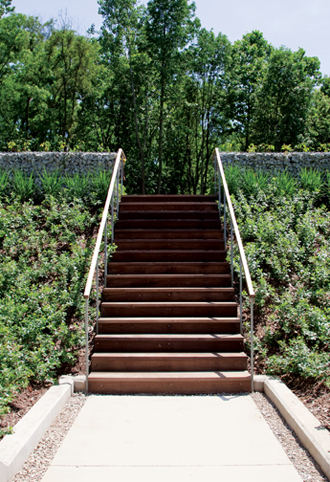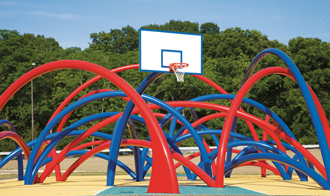Oberlin Alumni Magazine
Winter 2010-11 Vol. 106 No. 1
100 Acres Woodlands Wetlands Meadow Art Park
Lisa Freiman builds an enchanted place at the Indianapolis Museum of Art
 Alfredo Jaar, Park of the Laments, 2010
Alfredo Jaar, Park of the Laments, 2010
How can you be in the contemporary art world and live in Indiana? That was the question Lisa Freiman ’89 kept asking herself as she debated taking a job as head of the contemporary art department at the Indianapolis Museum of Art (IMA). "It seemed like a very unlikely combination, but I saw this beautiful institution and a tremendous amount of potential," she says.
Since arriving at the IMA in 2002, Freiman has been a driving force in reorienting the once-conservative encyclopedic institution toward cutting-edge art and, in the process, raising its profile nationally. Early on, she commissioned the acclaimed Brazilian artist Ernesto Neto to create one of his signature tented environments filled with squishy organic forms that visitors could sit on.
"It was the first time many people had experienced interactive art, and it opened up a whole new audience," says Freiman. She continued to test her belief that the public would be open to unfamiliar art by launching successful exhibitions by other leading contemporary artists, including Ghada Amer, Amy Cutler, María Magdalena Campos-Pons, and Félix Gonzalez-Torres.
Last June, 100 Acres: The Virginia B. Fairbanks Art & Nature Park opened to the public—a $25 million project that Freiman considers her most ambitious and unconventional to date. In the woodlands, wetlands, and meadows of the museum’s backyard (with a lake that’s prone to flooding), she’s reconceived the typical pristine, hands-off sculpture park by commissioning artists to make site-specific projects designed to be roughed up by nature and visitors alike.

Lisa Freiman
"We didn’t want the park to be a precious thing," says Freiman, whose rally-the-troops manner of talking about art is infectious. "You can touch and climb anything." Visitors can take a rowboat out to Andrea Zittel’s igloo-shaped island and see how local art students are inhabiting and modifying the experimental living structure. They can picnic on top of one of Joep Van Lieshout’s 20 benches shaped like bones that form an enormous human skeleton, or fish from Kendall Buster’s pier built from stacked organically shaped platforms suggestive of a topographical map.
Rather than tap big-name sculptors, Freiman has given younger and emerging artists—including Jeppe Hein, Tea Makipaa, and Type A—opportunities they haven’t had elsewhere.
Covering the opening of the park, Jonathan T.D. Neil wrote in Art Review that Freiman "is betting that the midwest, and Indianapolis in particular, can change the way both artists and the public think about, make, and engage with the tricky category of public art." Mary Sabbatino, vice president of Galerie Lelong in New York, who has known Freiman through the last decade, credits her courage and insight. "Two years ago when Lisa announced the list of artists for the park, it was clear that she had a totally different concept of the intersection of sculpture, community, and landscape," says Sabbatino. "She chooses artists who are making valuable, critical work but who aren’t on everyone’s list, and she will go to great lengths to protect their vision."
"I support a lot of underdog artists who are not represented by the top galleries nor are bringing in the top dollar," says Freiman. "The philosophy that difference is beautiful and productive, which is so crucial to Oberlin’s identity, has been essential to the way I think about my job and my relationship to art."
 Los Carpinteros, Free Basket, 2010
Los Carpinteros, Free Basket, 2010
Freiman, who grew up in New Jersey, was an aspiring artist herself when she arrived at Oberlin. But taking an art history survey course her freshman year was a game changer. "It was the first time this thing I liked to do was put into a historical perspective that I could reflect on," says Freiman, who went on to get her degree in art history. "I was amazed at the way it brought together so many different disciplines; it was a way of knowing the world through objects." She credits professor Bill Hood for introducing her to what a 360-degree intellectual experience could be and Pat Matthews for grounding her in theory and feminism.
Claes Oldenburg’s sculpture Giant Three-Way Plug outside the Allen Memorial Art Museum also proved to be seminal in Freiman’s life. "I remember thinking, the first time I saw it, ‘What the hell is that?’" says Freiman, who in her years at Oberlin liked to lean against the sculpture while studying in nice weather.
As a graduate student at Emory University in Atlanta in 1993, after working as a curatorial assistant at the Institute of Contemporary Art in Boston, Freiman was assigned to look at the relationship between abstract expressionism and Oldenburg’s 1962 The Store. She felt Oldenburg’s piece had more to do with Surrealism and dreams, and she made the case in her paper. "It was the first time I wasn’t a good girl intellectually and went out on a limb," she says. Freiman used the paper as a departure point for her thesis "(Mind)ing The Store: Claes Oldenburg’s Psychoaesthetics," published in 2001. Freiman is now working with Oldenburg to transform the thesis into a definitive scholarly monograph on the artist to be published in 2012.
In the meantime, after bringing the contemporary art world to Indiana to experience 100 Acres, Freiman is on to her next act. For the prestigious competition to choose the artist who will represent the United States at the 2011 Venice Biennale, Freiman proposed the Puerto Rico-based collaborative team of Jennifer Allora and Guillermo Calzadilla, who were selected in September by the Bureau of Educational and Cultural Affairs of the U.S. Department of State. While Allora and Calzadilla are well-respected multimedia artists, they hardly have the broad recognition of previous U.S. artist representatives such as Jasper Johns and Bruce Nauman. But for Freiman, who will be the commissioner of the U.S. Pavilion, another long-shot bet paid off.
Hilarie M. Sheets is a contributing editor to ARTnews and writes frequently for the New York Times.
